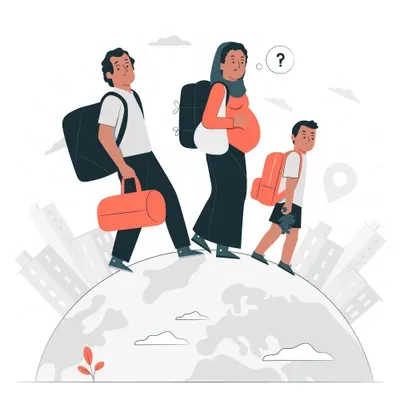The Exodus of Ukraine: A Tale of Resilience and Support
The Russian invasion of Ukraine in February 2022 triggered a massive humanitarian crisis, creating the largest refugee movement in Europe since World War II. By late May 2022, over 6 million Ukrainians had fled the country, while an additional 8 million were internally displaced. The majority of these refugees, approximately 90%, are women and children, given that most men aged 18-60 are required to stay and defend their homeland. The European Union, invoking the Temporary Protection Directive, has provided these refugees with the right to stay, work, and study across its member states for an initial period of one year.
 Ukrainian children fleeing Russian aggression. Przemyśl, Poland. Source: Wikimedia Commons
Ukrainian children fleeing Russian aggression. Przemyśl, Poland. Source: Wikimedia Commons
Historical precedents of Ukrainian migration have been driven by political and military turmoil. The annexation of Crimea in 2014 and the ensuing conflict in the Donbas region had already displaced over 2 million people. Yet, the 2022 crisis dwarfed previous waves, both in scale and speed. Some 3 million Ukrainians initially moved to neighboring countries like Poland, Slovakia, Hungary, Romania, and Moldova, with Poland alone hosting 1.6 million Ukrainians by mid-2023. Subsequent waves saw refugees moving further westward, with Germany accommodating around 1 million and the Czech Republic 540,000 refugees.
The response to the Ukrainian refugee crisis has been marked by extraordinary solidarity and support from European nations. Germany, led by Chancellor Olaf Scholz, has been particularly notable in its assistance, from providing immediate shelter and necessities to integrating Ukrainian children into local schools. Despite challenges such as logistical hurdles and instances of racial discrimination at borders, the overall narrative has been one of overwhelming support and successful integration. This has been aided by simplified employment processes and financial aid, enabling many Ukrainian refugees to find stability and work in their host countries.
As the war continues, the resilience of Ukrainian refugees and the robust support from host nations offer a glimmer of hope. The goal remains to ensure a safe and nurturing environment for displaced families, with a long-term vision of rebuilding their lives and eventually returning to a peaceful Ukraine. The ongoing crisis has underscored the importance of international solidarity and the ability of nations to come together in times of dire need, setting a precedent for handling future humanitarian emergencies.


